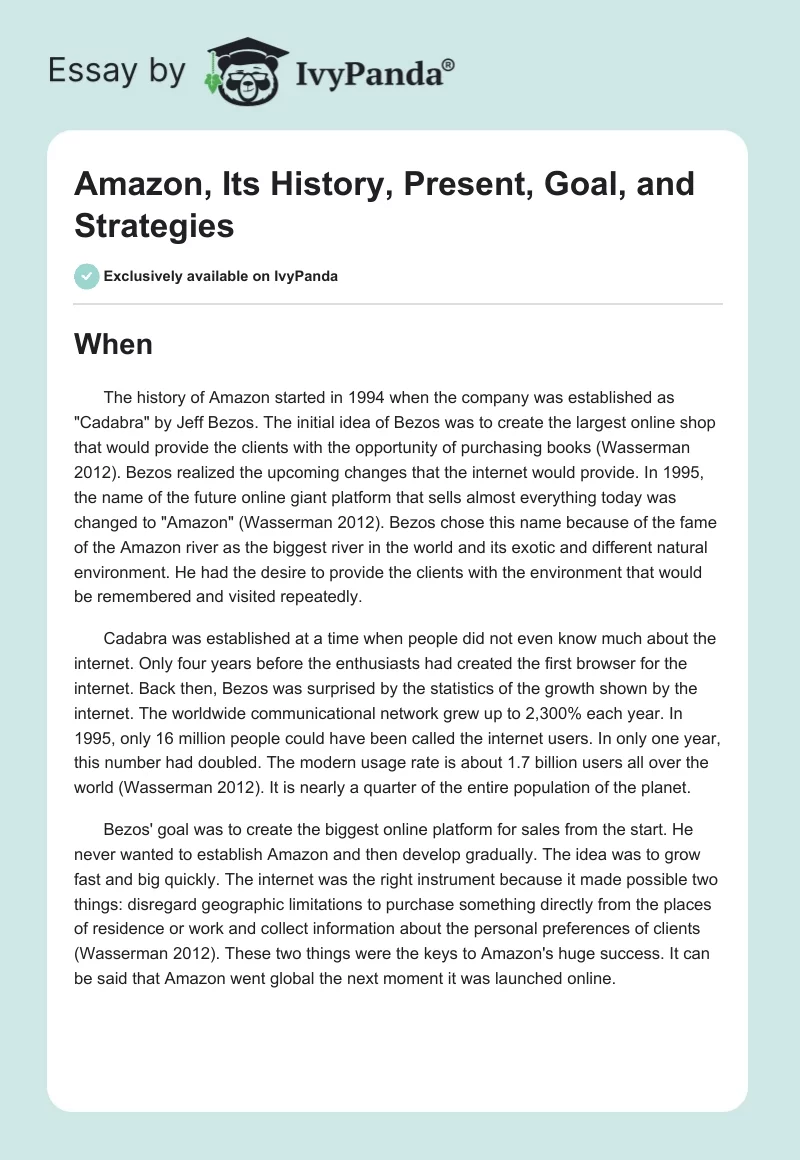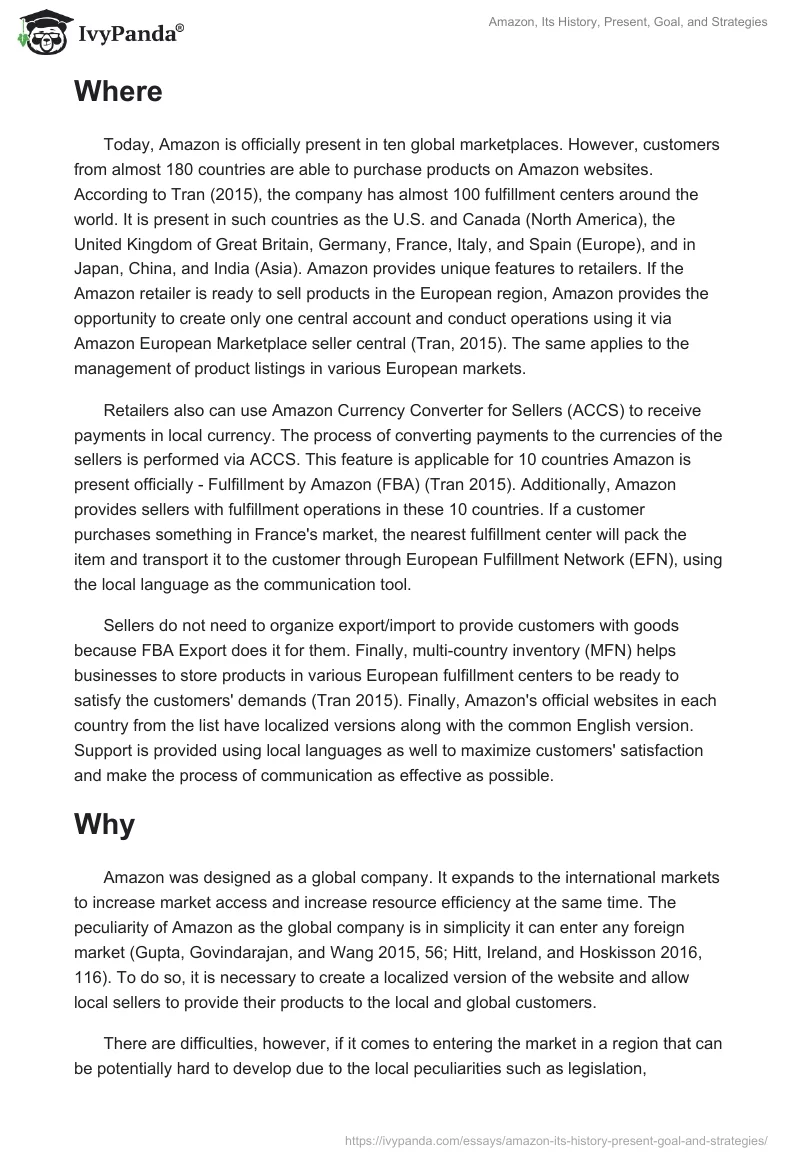When
The history of Amazon started in 1994 when the company was established as “Cadabra” by Jeff Bezos. The initial idea of Bezos was to create the largest online shop that would provide the clients with the opportunity of purchasing books (Wasserman 2012). Bezos realized the upcoming changes that the internet would provide. In 1995, the name of the future online giant platform that sells almost everything today was changed to “Amazon” (Wasserman 2012). Bezos chose this name because of the fame of the Amazon river as the biggest river in the world and its exotic and different natural environment. He had the desire to provide the clients with the environment that would be remembered and visited repeatedly.
Cadabra was established at a time when people did not even know much about the internet. Only four years before the enthusiasts had created the first browser for the internet. Back then, Bezos was surprised by the statistics of the growth shown by the internet. The worldwide communicational network grew up to 2,300% each year. In 1995, only 16 million people could have been called the internet users. In only one year, this number had doubled. The modern usage rate is about 1.7 billion users all over the world (Wasserman 2012). It is nearly a quarter of the entire population of the planet.
Bezos’ goal was to create the biggest online platform for sales from the start. He never wanted to establish Amazon and then develop gradually. The idea was to grow fast and big quickly. The internet was the right instrument because it made possible two things: disregard geographic limitations to purchase something directly from the places of residence or work and collect information about the personal preferences of clients (Wasserman 2012). These two things were the keys to Amazon’s huge success. It can be said that Amazon went global the next moment it was launched online.
Where
Today, Amazon is officially present in ten global marketplaces. However, customers from almost 180 countries are able to purchase products on Amazon websites. According to Tran (2015), the company has almost 100 fulfillment centers around the world. It is present in such countries as the U.S. and Canada (North America), the United Kingdom of Great Britain, Germany, France, Italy, and Spain (Europe), and in Japan, China, and India (Asia). Amazon provides unique features to retailers. If the Amazon retailer is ready to sell products in the European region, Amazon provides the opportunity to create only one central account and conduct operations using it via Amazon European Marketplace seller central (Tran, 2015). The same applies to the management of product listings in various European markets.
Retailers also can use Amazon Currency Converter for Sellers (ACCS) to receive payments in local currency. The process of converting payments to the currencies of the sellers is performed via ACCS. This feature is applicable for 10 countries Amazon is present officially – Fulfillment by Amazon (FBA) (Tran 2015). Additionally, Amazon provides sellers with fulfillment operations in these 10 countries. If a customer purchases something in France’s market, the nearest fulfillment center will pack the item and transport it to the customer through European Fulfillment Network (EFN), using the local language as the communication tool.
Sellers do not need to organize export/import to provide customers with goods because FBA Export does it for them. Finally, multi-country inventory (MFN) helps businesses to store products in various European fulfillment centers to be ready to satisfy the customers’ demands (Tran 2015). Finally, Amazon’s official websites in each country from the list have localized versions along with the common English version. Support is provided using local languages as well to maximize customers’ satisfaction and make the process of communication as effective as possible.
Why
Amazon was designed as a global company. It expands to the international markets to increase market access and increase resource efficiency at the same time. The peculiarity of Amazon as the global company is in simplicity it can enter any foreign market (Gupta, Govindarajan, and Wang 2015, 56; Hitt, Ireland, and Hoskisson 2016, 116). To do so, it is necessary to create a localized version of the website and allow local sellers to provide their products to the local and global customers.
There are difficulties, however, if it comes to entering the market in a region that can be potentially hard to develop due to the local peculiarities such as legislation, ineffective transportation system, issues in the financial field (unstable local currency, for example), and other similar difficulties (Dawson 2015). Today, Amazon is present in the largest and most active markets and regions. Eastern Europe and Russia develop very quickly, but as of today, their local situation does not allow the company to open official websites.
The goal of Amazon is to provide all customers with the same level of services. The platform provided by Amazon is very similar in its essence to the franchise by McDonald’s. Any seller can become the part of the Amazon business if this seller qualifies to provide goods of the appropriate quality. Amazon provides the infrastructure for sales, which is global from the start (Dawson 2015). Fulfillment centers and other supportive services from Amazon only help to assure the quality of the Amazon brand. The company sells products globally starting from 1995, considering the opportunities the internet can provide. Amazon only builds the necessary infrastructure worldwide to support the global status it had from the beginning of the operations.
How
The company provides its infrastructure to the sellers worldwide. Amazon builds fulfillment centers and creates localized websites to provide sellers and customers with the opportunity to meet each other on the pages of Amazon’s official websites. The goal of the company is to make the process of sellers’ support as simple as possible to attract more sellers with more products in the local markets. In other words, Amazon creates and develops the necessary infrastructure in each region to support sales (Gupta, Govindarajan, and Wang 2015, 89; Hitt, Ireland, and Hoskisson 2016, 189).
The company also develops innovative methods of the delivery of the product to speed up the process of orders’ fulfillment. Thus, the use of unmanned aircraft should provide many more opportunities to deliver products faster to the distant regions, for example, and decrease the use of transportation vehicles that pollute the environment. Additionally, robotizing the delivery process should exclude the human error factor, so the efficiency of the entire process should increase.
Amazon develops intensively according to the vision of the founder and CEO, Jeff Bezos. He sees the company as innovative and very customer-friendly, so innovations plus the unique feature of Amazon as the initially global company should provide it with continuous success (Gupta, Govindarajan, and Wang 2015, 102; Hitt, Ireland, and Hoskisson 2016, 205). This business can be expanded to the global markets easier and faster than any other business today.
Bibliography
Dawson, Jan. 2015. Amazon’s International Growth Challenge.
Hitt, Michael A., Duane R. Ireland, and Robert E. Hoskisson. 2016. Strategic Management. Concepts and Cases: Competitiveness and Globalization. New York: Cengage Learning.
Gupta, Anil K., Vijai Govindarajan, and Haiyan Wang. 2015. The Quest for Global Dominance: Transforming Global Presence into Global Competitive Advantage. New York: John Wiley & Sons.
Tran, Mai P. 2015. Amazon Global Selling: Tools and Benefits for Retailers.
Wasserman, Steve. 2012. “The Amazon Effect.” The Nation.


